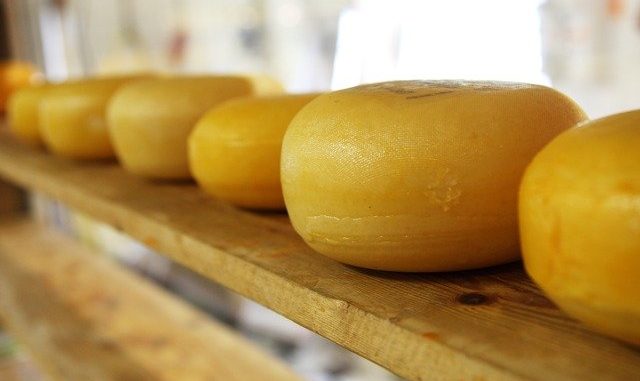
The making of cheese is one of the great delights coming from the dairy industry and let’s face it there are hundreds of varieties to choose from. There are amongst the many interesting types, certain varieties from the Middle East and some famous examples from the USA called Monterrey Jack and Colby.
Ingredients
The main ingredient in all cheese is milk. Cheese is prepared from cow, goat, sheep, donkey, water buffalo or a blend of these milks which all impart many different flavours and textures characteristic of the final cheese. The protein in the milk needs to be coagulated or curdled. The type of coagulant employed depends on the type of cheese required. For acidic cheeses, an acid source such as acetic acid or vinegar or glucono delta-lactone which is a mild food acid, is used. For rennet cheeses, calf rennet or, more commonly, a rennet produced through microbial bioprocessing is used. Calcium chloride is sometimes added to the cheese to improve the coagulation properties of the milk and help harden the cheese off.
Some cheeses have flavours added to them including various herbs like rosemary and sage, spices, fruit, chilli, hot and sweet peppers, horseradish, and port wine.
Manufacture Of Cheese
Milk is usually standardized so that subsequent manufacturing can be uniform, consistent and give good yields. Ensuring the cheese has the optimum protein to fat ratio is important which is also dependent on milk quality.
Milk Treatment
The milk is often pasteurised or given a mild heat treatment to reduce the number of spoilage microorganisms and provide a suitable environment in which the added starter cultures can be allowed to grow and ferment. The process can have a profound effect on cheese flavour and in many situations, raw, unpasteurised cheese is used to generate important flavours. Raw milk cheese has to be aged for at least 60 days to reduce the possibility of exposure to disease causing microorganisms or pathogens such as Listeria that can be present.
The milk is then cooled following its heat treatment to 90°F (32°C) to bring it to a suitable temperature needed for the starter bacteria to grow. If raw milk is used then it must be heated to 90°F (32°C).
In other variants of commercial processing, the milk following pasteurisation can be preconcentrated using ultrafiltration (Pouliot, 2008).
Inoculation with Starter & Non-Starter Bacteria and Ripening
The starter cultures and any non-starter adjunct bacteria are added to the milk and held at 90°F (32°C) for 30 minutes to ripen. The ripening step allows the bacteria to grow and begin fermentation, which lowers the pH making the milk more acidic and suitable for processing in the next step. It also develops the flavour of the cheese as various fats and sugars are metabolised.
Addition Of Rennet And Curd Formation
A type of enzyme, a protease in fact which hydrolyses proteins called rennet is added that acts on the milk proteins to form the curd. After the rennet is added, the curd is left for about 30 to 40 minutes so a firm precipitate or ‘coagulum’ forms.
Curd Handling & Heating
The curd ferments and hardens until it reaches pH 6.4. The curd is then cut with cheese knives into small pieces and heated to 100°F (38°C). The heating step encourages separation of the whey from the curd. The whey is then drained off from the container, usually a vat in which the cheese is being made where the curd left behind forms a mat.
Curd Formation And The Process Of Cheddaring
The curd mats are cut into sections and piled on top of each other and flipped periodically in a process called cheddaring. Cheddaring helps to expel more whey allowing the fermentation to continue until a pH of 5.1 to 5.5 is reached. The mats are permitted to “knit” together and form a tighter matted structure. These curd mats are then milled or cut into smaller pieces.
Brining Or Dry Salting Of The Curd
When a cheddar type cheese is manufactured, the small pieces of curd are placed in the vat and salted with dry salt where it is further mixed in. Mozzarella curd for example is cut into blocks or loaves which are salted in a brine solution.
Liquid whey is a byproduct of cheese making which is the remnant serum proteins such as lactoglobulin, lactalbumin, fat, lactose and salt. This used to be disposed of as waste or as animal feed but has now become a key component in itself as a source of proteins. We have discussed its composition elsewhere in our articles on whey.
Cheese Pressing And Storage
The salted curd pieces are placed into cheese hoops and then pressed into blocks to form the cheese. The freshly prepared cheese is stored in a cool place to age. Many cheeses are aged from a few months to many years. Parmesan cheese can be aged for up to 100 years before it is released to market. Some cheeses are wrapped in modern packaging but a traditional method of storing in a wax coating is also possible, keeping the cheese as moist as possible.
References
Pouliot, Y. (2008). Membrane processes in dairy technology—From a simple idea to worldwide panacea. International Dairy Journal, 18(7), pp. 735-740



Leave a Reply